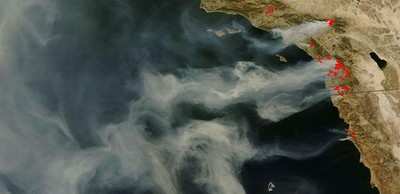As Many As Seven Aircraft Fly Reconnaissance Operations
 Now in their second week of
round-the-clock operations, the Civil Air Patrol's California Wing
members are conducting reconnaissance flights in support of various
federal, state and local agencies as part of the response to deadly
wildfires that have consumed more than 500,000 acres in seven
Southern California counties.
Now in their second week of
round-the-clock operations, the Civil Air Patrol's California Wing
members are conducting reconnaissance flights in support of various
federal, state and local agencies as part of the response to deadly
wildfires that have consumed more than 500,000 acres in seven
Southern California counties.
The California Wing was activated October 26, five days after
the fires began, in response to an Air Force request. The CAP
mission's incident commander, Maj. Robert Keilholtz, said members
have been assigned to search for possible victims in areas not
easily accessible by ground crews, and to take aerial photographs
of various buildings, facilities and towers used by both the
military and numerous civilian agencies. The photographs provide
vital damage assessment information to emergency services providers
on the ground.
Initially 30 CAP members flew seven CAP aircraft -- six Cessna
C-182s and one Gippsland G-8 Airvan -- from Gillespie Field in El
Cajon. Flight and support crews responded from as far north as
Fresno, CA.
Flight operations continue this week from CAP bases in San
Diego, Los Angeles, San Bernardino and Orange counties.
"Everyone in California Wing should be proud of the effort we've
put in so far while remembering that we're a long way from being
finished with our work," said 1st Lt. Tolga Tarhan, incident
commander-trainee. "Our imagery was so well-liked by the state and
the Air Force that we are now receiving several more major taskings
-- some of them are high priority and need to be done ASAP, and
some are long term, potentially requiring weeks to complete. There
are also smaller taskings on the way, such as transportation of
equipment."
Many California CAP members also have been working at the
Regional Emergency Operations Center-Joint Forces Training Base in
Los Alamitos, CA in administrative capacities since being activated
at the start of the fires, said 1st Lt. Matthew Scherzi, public
affairs officer for Falcon Senior Squadron 40 of the California
Wing. "We in California Wing are supplying three members per
12-hour shift, 24 hours a day, seven days a week until further
notice," he said.

Scherzi said the nearly 80 CAP members involved in the wildfires
mission range from emergency services-certified cadets to a former
wing commander. "By doing administrative duties, CAP frees up
firefighters and other state and local emergency responders for
even more critical duties," he said. "Several members have worked
multiple shifts over the last week."
The California Wing of the Civil Air Patrol has a long-standing
relationship with the REOC and the Governor's Office. The wing
transported equipment during the 1993 wildfires that destroyed more
than 1,000 homes in six counties in Southern California. During the
Los Angeles riots and for several weeks after, CAP members provided
24-hour communications assistance at the REOC at Los Alamitos. They
also were involved in several missions during the Northridge
Earthquake in 1994 in which they supported the Red Cross for 60
days.
Keilholtz, who lives in Solana Beach, was one of hundreds of
thousands of Southern Californians who fled their homes last week
ahead of more than 20 wildfires fueled by the region's fierce Santa
Ana winds. At the height of the fires, almost one million people
were under evacuation orders. More than 2,000 homes have been
destroyed. At least 14 people have died.

Another evacuee, Maj. Joseph Di Mento of Fallbrook Senior
Squadron 87, said, "My family was fortunate to have escaped the
conflagration in and around Fallbrook, while others lost everything
they had in the fires. I'm just happy to have had people there to
help us."
 Aero-News: Quote of the Day (12.09.25)
Aero-News: Quote of the Day (12.09.25) ANN's Daily Aero-Term (12.09.25): High Speed Taxiway
ANN's Daily Aero-Term (12.09.25): High Speed Taxiway ANN's Daily Aero-Linx (12.09.25)
ANN's Daily Aero-Linx (12.09.25) NTSB Final Report: Diamond Aircraft Ind Inc DA20C1 (A1); Robinson Helicopter R44
NTSB Final Report: Diamond Aircraft Ind Inc DA20C1 (A1); Robinson Helicopter R44 ANN FAQ: Q&A 101
ANN FAQ: Q&A 101





